


Fungus the Bogeyman is a 1977 children’s picture book by British artist Raymond Briggs. It follows one day in the life of the title character, a working class Bogeyman with the mundane job of scaring human beings.
The book follows a typical day for Fungus the Bogeyman, starting when he wakes up and ending just before he falls asleep. As his day progresses, he undergoes a mild existential crisis, pondering what his seemingly pointless job of scaring surface people is really for. He is a member of the Bogey society, which is very similar to British society, but Bogeymen enjoy things which humans (called Drycleaners because of their contrasting environmental preferences) would not be comfortable around; for example darkness, damp, cold and over-ripe food. The book depicts the mundane details of Bogey life in loving detail, with definitions of Bogey slang and numerous annotations concerning the myths, pets, hobbies, literature, clothing and food of the Bogeys.
https://en.wikipedia.org/wiki/Fungus_the_Bogeyman
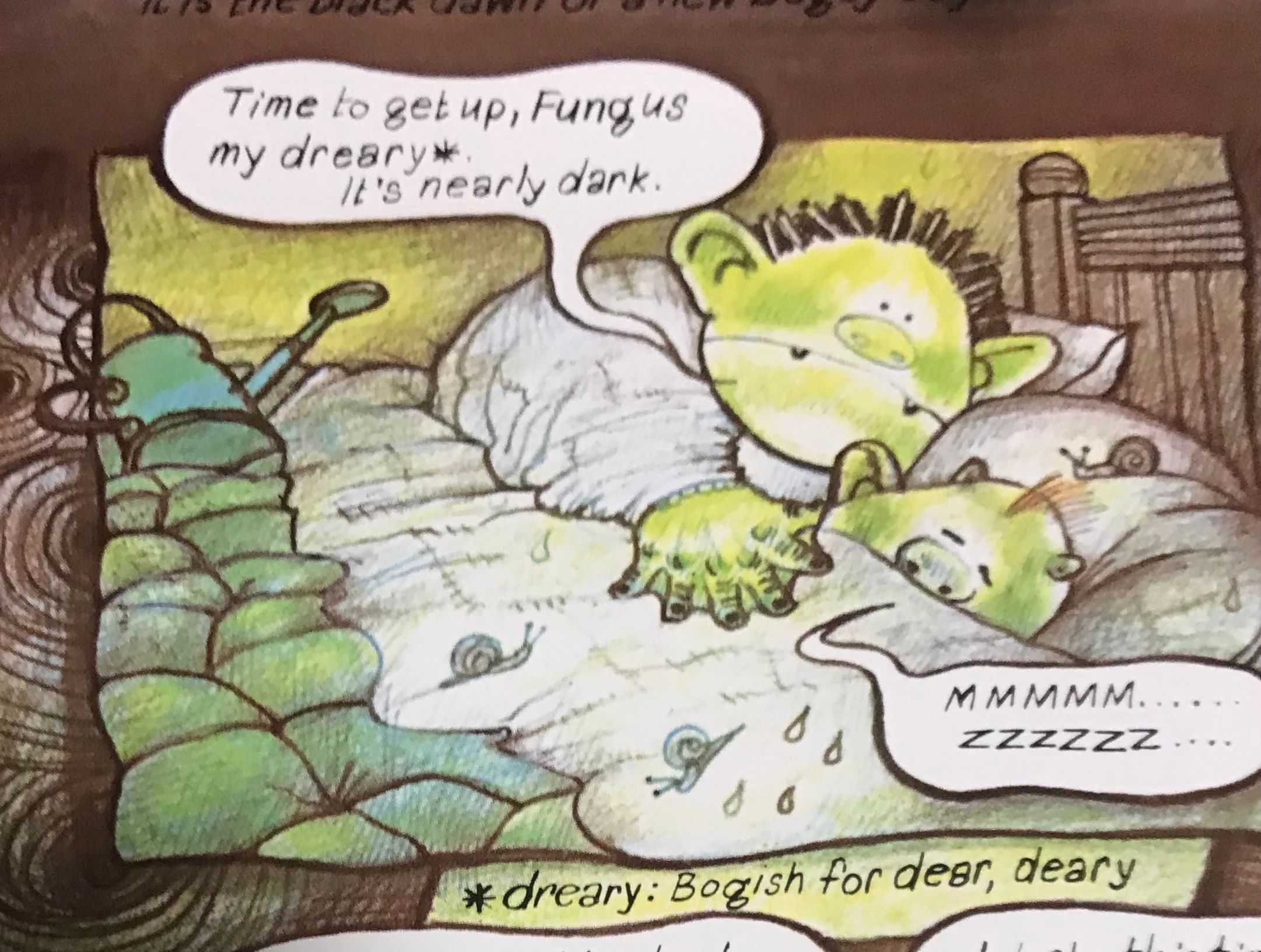
Melancholy, erudite, beautiful, funny. Fungus the Bogeyman is a lovingly created work of art, with as much care and thought in the words as in the images. Almost documentary-style, the book follows a day in the life of the title character, his work and home life, and along the way introduces the culture and manners of his people, the Bogeys, whose occupation is frightening humans, also known as the surface-dwelling “Dry Cleaners”. As the day progresses, we learn more about Fungus and his philosophical self-doubt.
Through the richly-detailed pages, contrasts and parallels are revealed between the gentle, disgusting Bogeys, and humans.
Tom Hurst https://www.goodreads.com/review/show/4711469513

It has been called “the nastiest book ever published for children,” and it stands in a pivotal position among the picture books of the British artist-writer Raymond Briggs. Fungus the Bogeyman offers both the most fully developed fantasy and the most outrageous affront to conventional mores of all Briggs’s children’s books to date. It also marks the midpoint of a philosophic curve Briggs has been tracing from the cheerful confidence of Jim and the Beanstalk (1970), to the black despair of When the Wind Blows (1982). A close look at Fungus reveals the common concerns that tie these two extremes together, and that make the last book a wholly logical development from the first. Bogies, according to K.M. Briggs’s Encyclopedia of Fairies, comprise “a whole class of mischievous, frightening and even dangerous spirits whose delight it is to torment mankind.” From this basis in folklore, Raymond Briggs has postulated a race of large, blobby, green-skinned beings who inhabit their own underground world. At night (their day), the Bogeymen emerge to carry on their “work”—frightening human beings with mysterious footsteps, scrapings on windowpanes, and an occasional graveyard appearance; they also cause boils. But we see the daily life of Fungus at home too, eating breakfast with his wife and son, bicycling off to work, and stopping off at a pub on the way back. Meanwhile, as an anonymous narrator fills in a complete picture of Bogeydom, lecturing in academic style on Bogey culture, sports, flora, fauna, and anatomy, Briggs utilizes the full subcreative power of fantasy, supposing not only magical powers (as he does in Father Christmas and The Snowman), but a race of imaginary beings and their entire world. Fungus is Briggs’s most deeply fantastic book for children and his most startling. Indeed, both in form and in content, it could scarcely be better calculated to repel the adult reader—or intrigue the young one.
SuzanneRahn https://www.researchgate.net/publication/236787432_Beneath_the_Surface_with_Fungus_the_Bogeyman
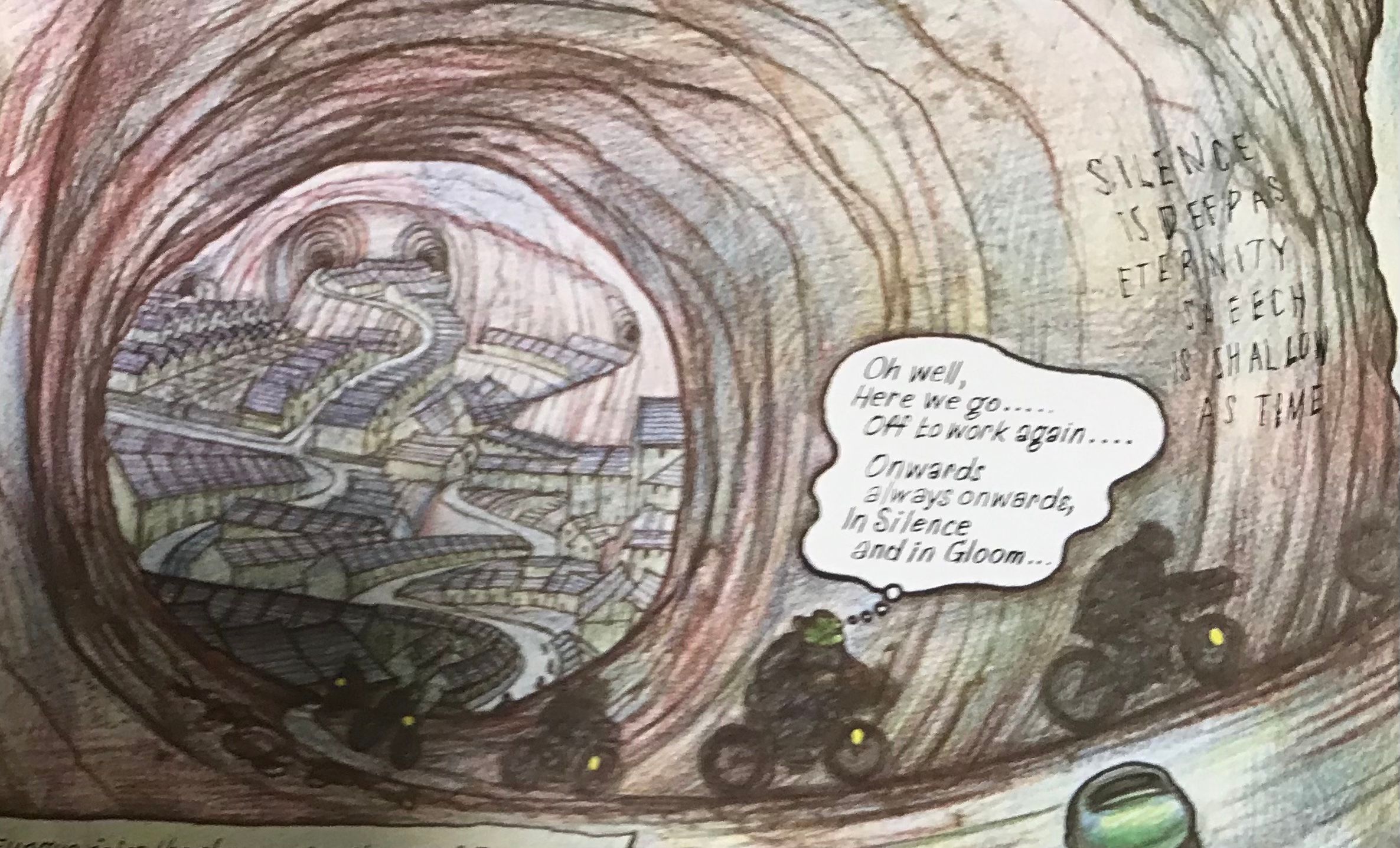
Far from being a simple celebration of all things wet and slimy, Briggs’ book creates an upside-down underworld where a gloomy nihilism is the order of the day, and with whose attitudes Briggs clearly has some sympathy. The book was first published in 1977 and has a definite punky, “no future”, Sex Pistols quality.
The Bogeymen have something of the grumpy old man about them. They abhor anything new, and for that reason do not buy newspapers, but rather oldspapers. Posters on the walls advertise events long since passed.
It is an appealingly slow world. Bicycle tyres are filled with goo and sailboats are square-fronted to ensure slow sailing. Their games, such as pig-sticking and tiddlywinks, are non-competitive and can last for days. In Bogeyball, there is no cheering or shouting and the players glide dreamily around in the thick mud, with a grace, Briggs says, “which makes the fussy scrurrying around of Surface footballers appear slightly ridiculous”. The purpose of angling is to avoid catching fish, and any Bogey who does so will retire shamefacedly to a bar.
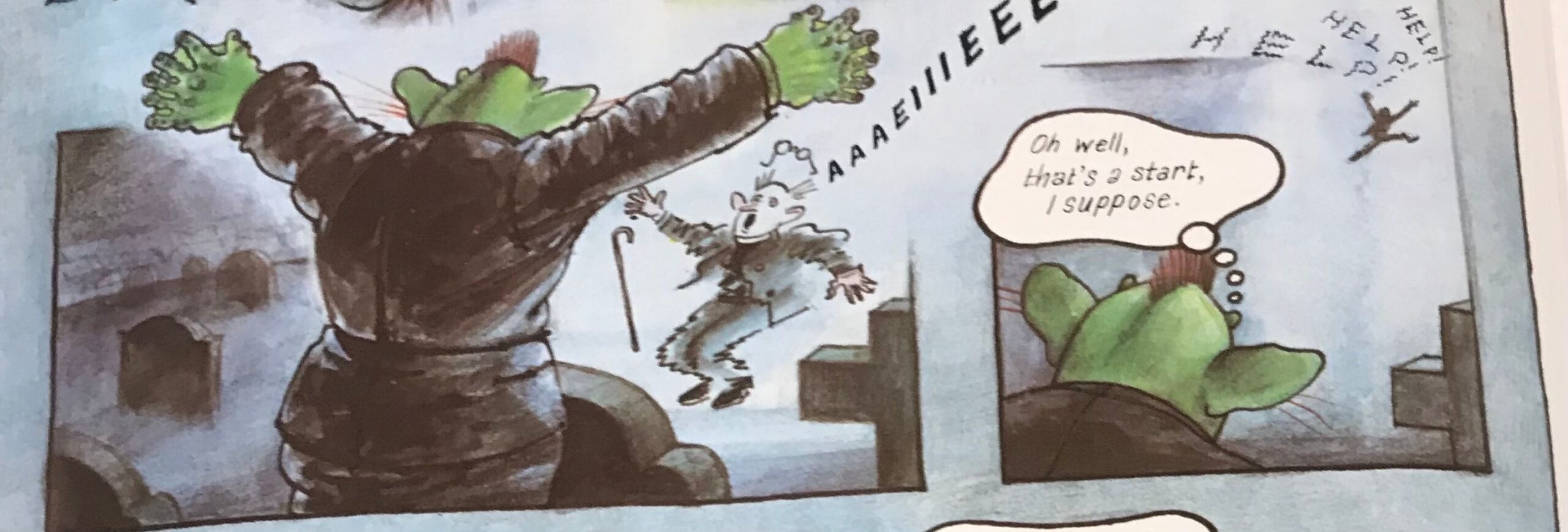
Bogeys love sleep and the outdoors is dotted with dreamholes, whey they will retire for a nap. When their problems appear insurmountable, they simply retreat form the world and may go to sleep for up to a year in specially created graveyard-like zones called “interests”.
The book masterfully combines a thorough anatomy of Bogeyworld with a meditation on the futility of existence. As Fungus moves slowly through his day (or, I should say, his night, since Bogeys are nocturnal), he is given to such reflections as “Not to reason why… not ask questions… just keep bogling away”.
And that brings us to the vexed question of the Bogeyman’s job: frightening humans. In the book, it is Bogeys like Fungus who spend their nights separating socks, kicking tiles off the roof, creaking the stairs and banging the dustbin lids. They also press their green fingers on the necks of sleeping humans in order to create boils. Why?
All of Briggs’s work is great but I think Fungus is his masterpiece.
Tom Hodgkinson https://www.theguardian.com/books/booksblog/2007/apr/24/whatimreadingfungusthebog
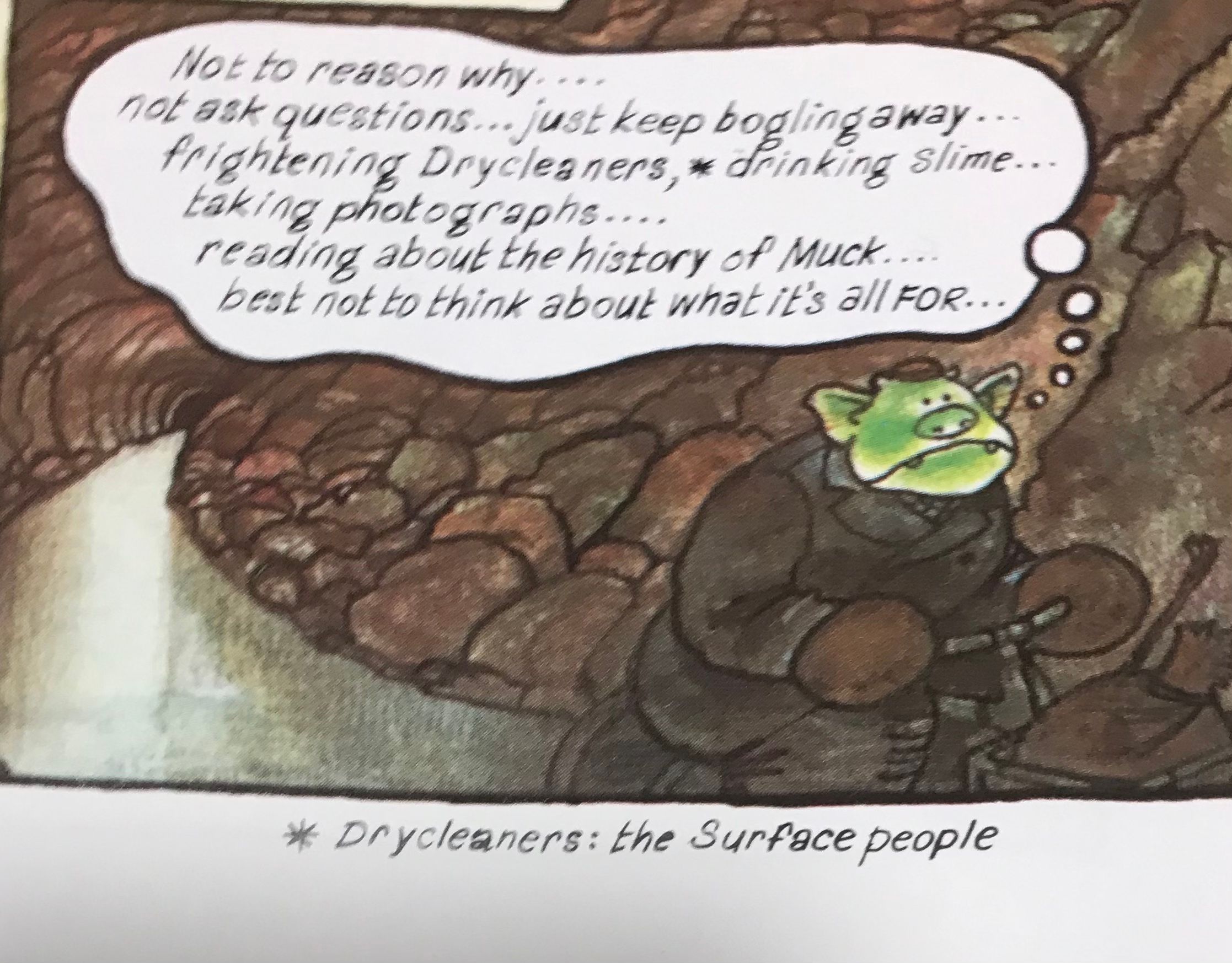
Raymond Redvers Briggs, an only child, was born in midwinter 1934 to Ethel, a lady’s maid, and Ernest, a milkman. Long before they appeared as themselves in the deeply moving Ethel & Ernest in 1998, Mr and Mrs Briggs floated in and out of their son’s books like kindly spirits. Believe it or not, Fungus the Bogeyman was inspired by Ethel, whose sweetness is very much at the fore. A less than earnest milkman offers Tilly 20 pints to feed her ursine guest in The Bear and greets Father Christmas with a knowing ‘Still at it, mate?’, as he makes his own chilly rounds. Briggs dedicated Father Christmas to them both following their deaths in 1971.
Briggs has written of his regret at how often people take the fact of having a family for granted. In Notes from the Sofa, a compilation of his witty columns for The Oldie, he jests about inviting his — a lone cousin — to a ‘big family get-together’ for Christmas. Should he hire a hall? Tragically, Briggs lost his wife Jean, who was schizophrenic, to leukaemia the year Father Christmas was published. Liz, his partner since around 1975, passed away in 2015. While Briggs often spends the season with her children and grandchildren, he cannot help but think of those who have no one at this time of year.
Isolation is very much at the heart of his books. Father Christmas has an entire turkey, pudding and ‘party size’ bottle of red to himself. Not too shabby, you think, eyeing his enormous feast. And yet, here’s the chap who enters more homes than anyone else, resigned to spending Christmas day alone, with only his cat, dog, and beloved deers for company. He has just about the loneliest job in the world.
As a child, of course, it doesn’t occur to you to pity him. You are too busy laughing as he brushes his hair and beard simultaneously — separate brushes, please — and rests his derrière on the outside latrine. The young imagination overcomes loneliness by conjuring company out of thin air. Such is the phenomenon Briggs’s books celebrate. Characters emerge fully formed, the Snowman so human that he covers where his genitals should be after trying on some trousers, feeling, like Adam, shame at his nudity for the first time. Only when you reread these books in adulthood do you comprehend the sadness through which imaginary friends may grow and perish.
You may not be surprised to learn that Briggs — who trained at Wimbledon School of Art, Central, and the Slade — is an admirer of Bruegel the Elder. The artist’s peasant-filled winter landscapes have a darkness that permeates the beauty of their setting. Where Bruegel’s snow is so thick it looks unlikely ever to thaw, Briggs’s is as fine as the lines that describe it. Like the imagination, it is transient, destined to melt into puddles, like those of The Puddleman.
Daisy Dunn https://www.spectator.co.uk/article/the-grumpy-genius-of-raymond-briggs
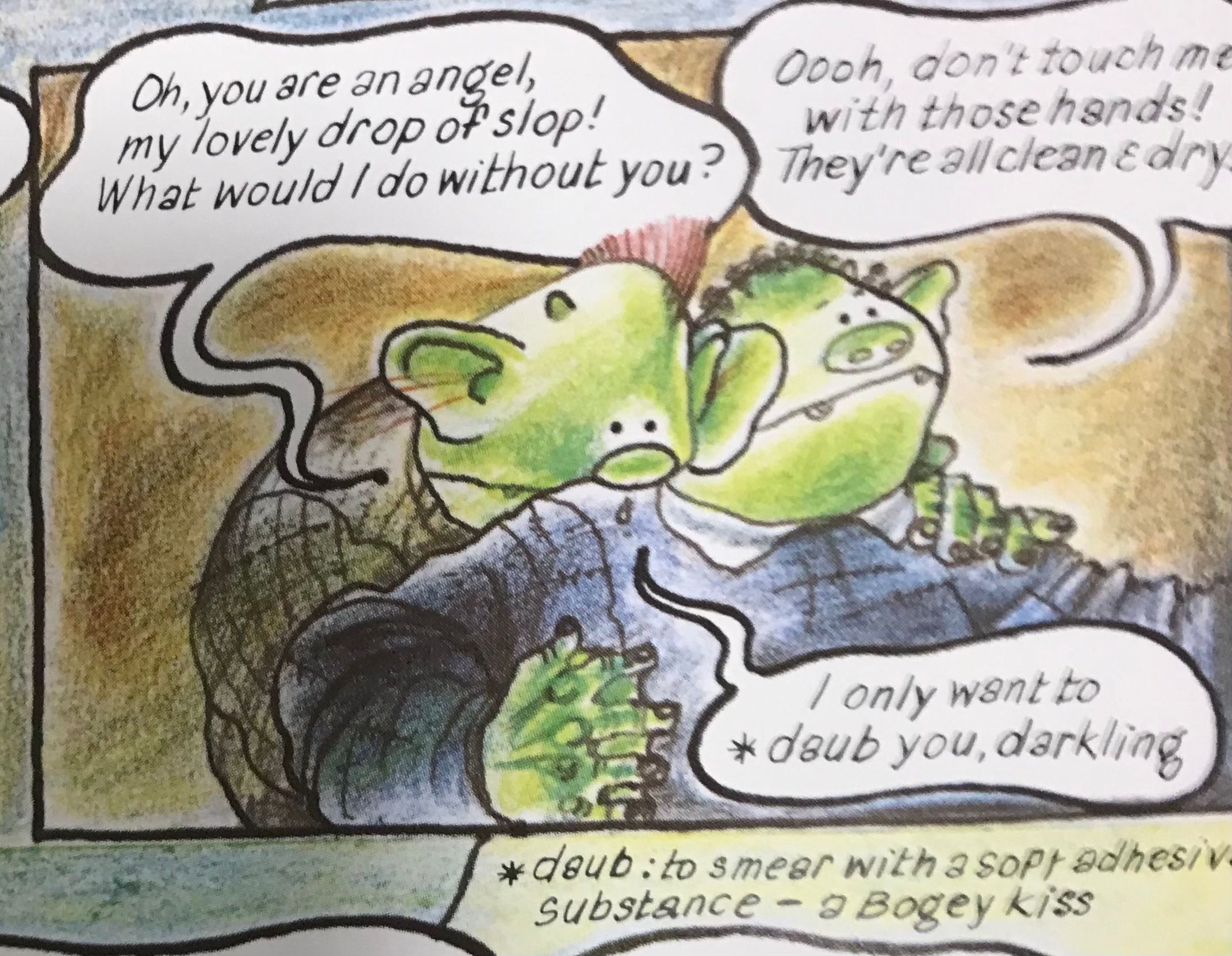
I was 12 when Fungus came out in 1977. I bought it with my pocket money from High Hill Bookshop (RIP) in Hampstead High Street in north London and pored over it for hours in a state of repulsed yet instantly adoring fascination. The disgusting detail! The spirit of punk that informed every frame!
But the sensibility of the Briggs cohort was so wildly inventive, so risk-taking and unafraid, so art-school in its outlook, that I worry we will not see their like again. I think it’s because this sensibility was adult. Many of today’s writers and illustrators write as though they were children, with a faux-naif child’s sensibility.
Briggs and so on were very clearly adults, making books for children. This meant their work was meaty and had real heft. Fungus is essentially having an existential crisis — he spends the day wondering what he is for. Father Christmas is knackered, highly irritable, and he needs a drink, which makes his flashes of tenderness all the more affecting.
Illustration is supposed to show you surface, but these illustrators took us far beneath that — some of their work was almost novelistic and therefore deeply satisfying.
I worry that some of this is lost with some contemporary children’s picture books, which seem so nicely and predictably behaved. They are thoughtful and inclusive, which is obviously great, they teach a nice moral lesson about sharing or suchlike, hurrah (and also, slightly, yawn), but the most anarchic or subversive they get is poo, pants and fart jokes — all of which have their place, and many of which are funny, though perhaps not as hideously funny as the Plop-Up edition of Fungus the Bogeyman. But they are not thrilling.
You don’t gasp as you turn the page. You aren’t shocked, and there isn’t that sense of being absolutely and instantly submerged in a whole other world where strange things might happen.
Perhaps this is why the Snowmans and Funguses of the world, along with the entire oeuvre of Roald Dahl, endure. At least they haven’t been cast out into the wilderness.
If novels by Jane Austen and Charlotte Brontë now come with trigger warnings, as has been reported — I do wonder how young people, raised on porn and video games, are apparently left cowering by the deeds of fictional characters — then that leaves Fungus perilously exposed, trousers down and on the lav, probably, which is just the way he’d like it.
India Knight https://www.thetimes.co.uk/article/snowman-author-knew-kids-werent-snowflakes-666fp5x7c
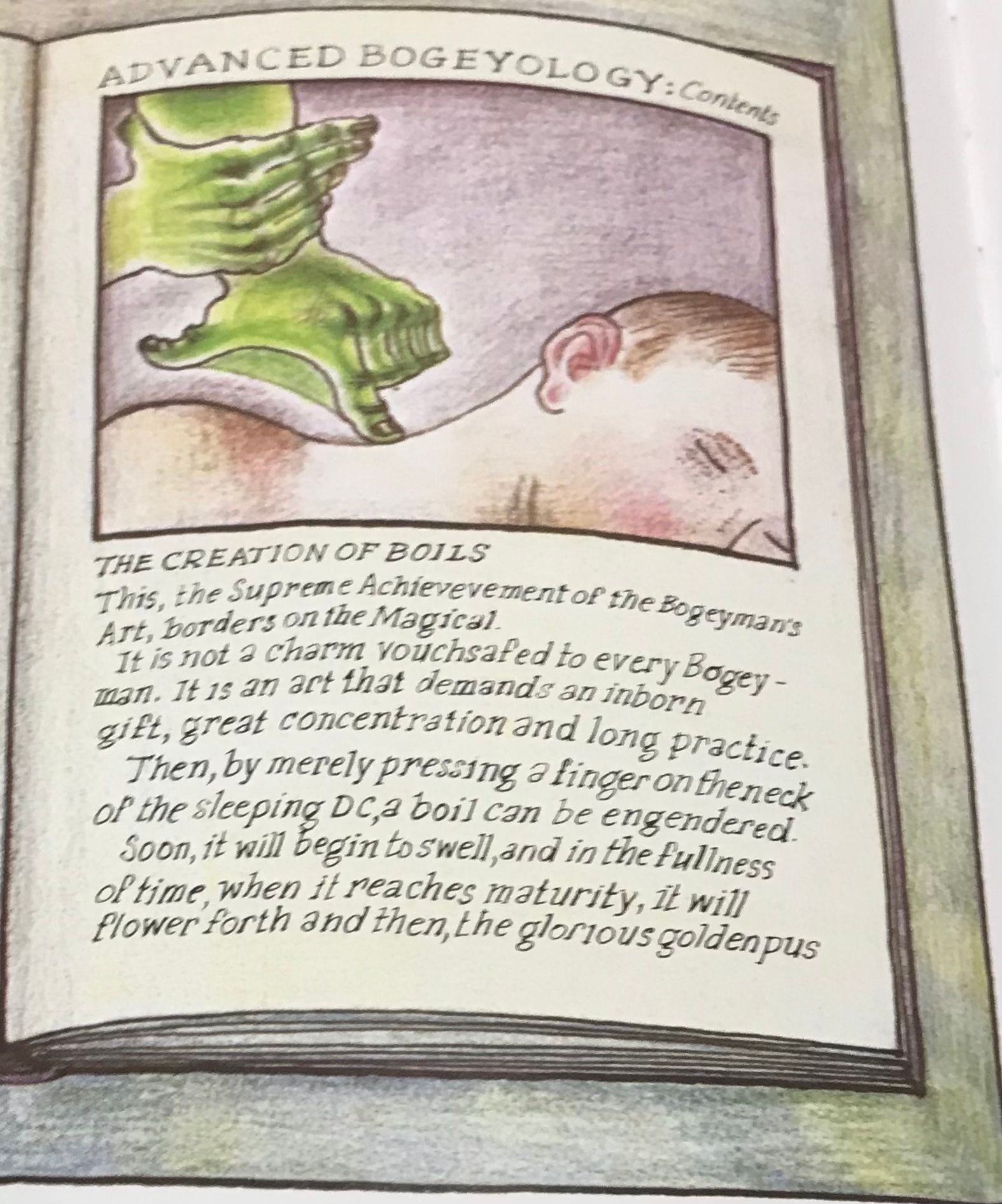
Raymond Briggs, who has died aged 88, did a great deal to elevate the art of illustration to being something much more than a servant of the written word. Though he was best known for his hugely popular books Father Christmas (1973) and The Snowman (1978), his output also explored themes such as war, politics and the environment through a deeply human, very British lens that often settled on the quiet heroism of ordinary lives.
Briggs may be seen to sit comfortably in the English anecdotal tradition exemplified by Randolph Caldecott in the 19th century and Edward Ardizzone in the 20th, but his often wordless graphic literature built bridges between the picture book and the comic or graphic novel, introducing a new way of reading to the adult publishing market, or at least asking grownups to relearn the business of reading a silent visual sequence.
Fungus the Bogeyman (1977) could be seen as a character very much close to home, displaying as he does an extreme version of the author’s own tendency to be outspoken and impatient.
At Hamish Hamilton the newly arrived editor Julia MacRae (later to set up her own imprint) played a major role in developing the artist’s career. The illustrator John Lawrence, who was also published by Hamish Hamilton, recalled those days with great fondness: “All the talk was about ‘is the world ready for Fungus the Bogeyman?’ and we all turned up at the launch party in green wellingtons surrounded by buckets of suspicious-looking green liquid, wondering whether it might be the wine.”
Briggs’s keen interest in narrative drawing was not welcomed at Wimbledon School of Art, which was rooted in traditional representational painting. He recalled: “I had gone to art school to learn to draw so as to become a cartoonist. But I was soon told that cartooning was an even lower form of life than commercial art.”
Loyal and playful, an inveterate practical joker. Lord once made the mistake of confessing to a dislike of dogs in the presence of Briggs, thereby immediately committing himself to becoming the recipient of all manner of canine-related gifts on subsequent birthdays and Christmases. Like so many of his characters, Briggs’s grumpiness never quite managed to conceal an underlying warmth and kindness.
Martin Salisbury https://www.theguardian.com/books/2022/aug/10/raymond-briggs-obituary
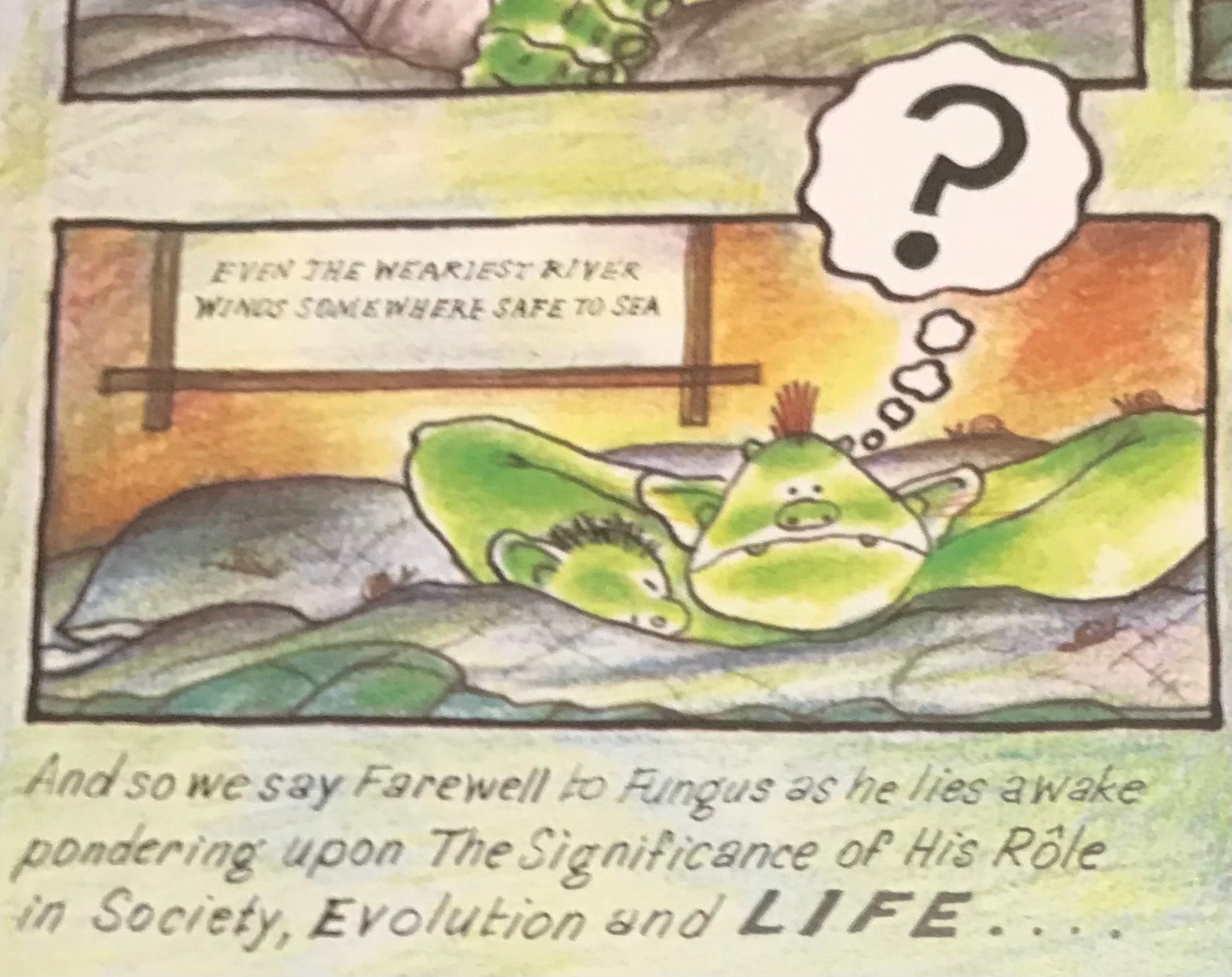
*
p.s. Hey. Today the mighty musical curator, writer, bon vivant, style icon and upstanding DC’s veteran _Black_Acrylic (aka Ben Robinson) commandeers the blog with my supreme blessing to pay tribute to his (and many people’s) favorite work by the recently and sadly late British artist Raymond Briggs. It’s quite a treat, folks, so give it your all and please, if you don’t mind, send a word or more in your comments to _Black_Acrylic to thank him for his generous and pointed work. Thanks, and thank you ever so much, Ben. ** Florian-Seraphim Fauna, Hi, Florian! I’m excited about it too, as you gathered from my ‘like’, and I’m relieved it’ll be digital since my cassette player days are in the past. My end? Mostly getting ready to shoot Zac Farley’s and my new film and working on some fiction and counting the seconds until horrible summer is over. And you? ** Dominik, Hi!! Thanks a lot, pal. Big agree on Christopher Knowles. Thank you re: the weather. Supposedly after an awful today and especially tomorrow, the descent will begin, and it had better be the summer’s final descent, or else! No, no mind blows since the potential mother actor. But we’re looking at video auditions. Oh my god, I loved tomato soup with little alphabet dough things in it. Love is not alone in his cravings. Can one still buy that kind of soup? Must be, no? Today I just want to love to have very poor eyesight and to have forgotten his glasses and to be coincidentally carrying an AK47 and to see the summer and mistakenly think it’s Putin and assassinate it, G. ** David Ehrenstein, So, you’re secretly another woman in love? That is a reveal! Everyone, If you’re in or around LA, Mr. Ehrenstein has some bargains for you: ‘Le Berceau de Cristal (1976) by Phylippe Garrel, poster by Frederic Parso. Film with Nico and Anita Pallenberg $100.00 / ‘Raging Bull’ (1980) Wood Frame and close-up of Robert DeNiro under glass $75.00 / ‘1900’ (1976) Bernardo Bertolucci $20 // David Ehrenstein / 1462 S. Shenandoah St. #7 / Los Angeles, Ca. 90035.’ ** James Benning, Hi. First, my apologies if necessary for the follow short stretch of gush, but you’re one of the most important artists to me, a big influence on both my work and the films I make with Zac Farley, and it’s an astonishment to have you on my blog. Finding your work via a screening of ’11 x 14′ at Filmex back in the day permanently changed the way I think about making and seeing things. Thank you for everything. Secondly, thank you for the Jesse “Outlaw” Howard link. I don’t know his work, and now I will. Everyone, The very great filmmaker James Benning suggests Jesse “Outlaw” Howard’s work be added to the wordage shebang yesterday. Please investigate. Thank you again, and great respect! ** Tosh Berman, Very happy to contribute, sir. ** Sypha, Hi, James. Is that how I put it? Yeah, I still agree. I’m really sorry to hear about all the travails you’re being forced to deal with you. Your place in the blog’s heart and lexicon are ever assured, and time is a blip here. Here’s heavily hoping your family vacation will be restorative. I think they usually are, right? I loved ‘Mudmonster’ too, don’t you know. I’ve been good except for hating the summer like I always do. Yeah, Zac and I are preparing to shoot our new film, tentatively just after Xmas. Lots to figure out. And I’m working on some short fictions. Yay for your completism! Take care, pal, and I hope to see you again soon. ** _Black_Acrylic, Thank you so much again ‘in person’ for today’s splendors, Ben! Yes, the French like football so much that they even care about non-French football! ** Bill, Hi, Bill. Thanks about the heat. It’s mostly today and especially tomorrow. The plan is to hunker down today first in a big Elsa Schiaparelli exhibition and then at the Hard Rock Cafe for some nachos. And tomorrow I think I might use the ugly sky as a reason to finally go see ‘Nope’. Yes, get back to your unstable text project ASAP! My brain is growling like a stomach. And that post would be awesome too, natch. Any particularly exciting gigs? ** Brendan, Hi, B! Oh, man, you so lucky! What a lineup, good lord! Who were the most amazing, and who were the most sadly wanting? If any? This week! Cool, give me/us the heads up, master. ** Travis (fka Cal), Thank you, Trav! I’m not on Instagram, ridiculously, I know, but I’ll take a peak before they shut me out. Everyone, Go check out the work the excellent artist and etc. Travis (fka Cal) over at Instagram by clicking this. Good, happy your mood is heading upwards and that you’re back to work. Actually just working is almost always the cure. And thanks so much about ‘God Jr.’. I really appreciate it. ** Right. _Black_Acrylic has you covered, and you’re in excellent hands, and I’ll see you again tomorrow.




 Now available in North America
Now available in North America 
Dennis, Leave it to Ben to do another mind-blowing Day.
Ha! I’ll just jump into it blind. Essentially, I just kinda sit around waiting for people to contact me to proofread the documents they’re working on. There are lulls, but it’s usually pretty steady and very often nonstop. I just jump in the fire and…get burnt.
Really, you know, after having that week off, I would have no problem if someone wanted to pay me, say, $10,000 (way above my pay grade, of course, hahaha) tax free not to work. I’m lazy like that. Though I’d be doing other stuff. I did enjoy just waking up whenever and do whatever floated my boat. I could make a life of that, hehehe.
But Reality sets in and…bleh.
😀
Hello dennis. Many thanks to Ben for such a great post. I had never heard of Fungus the Bogeyman but I will definitely be sourcing a copy in the distant future for my son. The world building is fantastic and I love the ick factor.
Thanks for sharing,
Ian
Hi!!
I have to say, I was a little surprised when I saw the title and theme of today’s post – and intrigued enough to jump right in. I’ve never heard of “Fungus the Bogeyman.” I wish I’d known it as a child – I’m sure I would’ve loved it. Reading oldspapers, playing strictly non-competitive games, and crawling into dreamholes (what a thrilling name!) and “interests”? Yes, please. Even now. So, thank you, Ben & Dennis, for this treat!
I can only hope that your nearsighted love with his handy AK47 is around in Paris right now…
I’ll keep on keeping my fingers crossed for the video auditions then!
I got a packet of alphabet pasta from one of my cousins last year(ish?), so it’s still around. (Now that I’m writing this – it’s a pretty weird gift, haha.) But I hadn’t eaten it before that for ages.
Love kindly possessing my friend and uninviting me to her bachelorette party, Od.
@ Misanthrope, cheers George!
@ Ian, I hope your son enjoys this story a great deal. I know I did back in the day.
@ Dominik, cheers! I’m very glad to make the introduction. Briggs’s other books are also really good and are very highly recommended.
@ Dennis, thank you for hosting this day. It was all cobbled together out of pics taken on my iPhone here at the East Leeds Recovery Hub. Think it turned out alright in the end.
Only the British ha ha… but the mention of Roald Dahl reminds me of the time when I was in (I think) 3rd grade and the teacher read JAMES AND THE GIANT PEACH to us, a book she didn’t seem to like much (later I got my own copy and found out that when she had read the book she had left some of the nastier bits out). Anyway I have a feeling I would have enjoyed this book as a kid.
“Your place in the blog’s heart and lexicon are ever assured, and time is a blip here.”
Ah, thanks! I seem to have gone from “someone who posted here everyday” to some eccentric uncle type who drifts in and out of the public sphere. But I’m glad to hear that you and Zac are still in the filmmaking milieu, and that you yourself are working on short fictions.
I myself have not been doing much fiction writing recently, in fact over these last two years I’ve only written 2 short stories (one for my still unfinished PLEASANT TALES III collection, the other for a new Neo-Decadent anthology that Justin Isis is editing, and which will be out this autumn I think). But I’m kind of burnt out from short stories in general: I actually often find them harder than novels to write, and as it is over the last 20 years I’ve written like 62 of them total. I want to go back to novels at some point, but in the meanwhile recently I’ve started a series of childhood reminiscences on my writer’s blog. Because I tend to not be a very self-autobiographical writer, I wanted to at least leave some record of my past behind for posterity, so figured, if I couldn’t do it through fiction, just dump it on the blog ha ha.
I thought of you when I read Lenika Cruz’s essay about the pleasures of watching movies on airplanes, published today in the Atlantic.
That “not to reason why…not to ask questions…best not to think what it’s all for” image is devastatingly sad. It could be a doomer meme, not a children’s book from the ’70s.
I spoke with Roger Shepherd for 40 minutes last night. The interview does a pretty good job of starting out in the landscape of ’70s New Zealand rock music and describing the start of Flying Nun and the label’s increasing slickness and need to find an international audience. I would’ve liked to talk a bit more about their current artists – the Recitals’ ORBIT I, which comes out Friday, is a sprawling art-rock project – but I’m not sure how involved Shepherd is with them. Anyway, I’ll be interviewing Ricky D’Ambrose tomorrow, so my week’s pretty busy.
I’m not familiar with Fungus, ha. What a nutty concept. And I have to note, in the section On the Creation of Boils, there’s a comment about “pressing a finger on the neck of the sleeping DC”, hmm. Hope your neck stays boil-free, Dennis.
The unstable text project is moving along slowly. Recent gigs include Charles Sharp, a free jazz/improv sax player who’s an old friend from around here, now living in Long Beach, and a set of cello/guitar/koto duos at the Asian Art Museum, by Theresa Wong and Kanoko Nishi-Smith. There are quite a few events this weekend as well, so I better make more progress soon.
Bill
Ben – thank you for the post! I’ve seen the book around but never read it for some reason. I knew so little about Briggs apart from the obvious Christmas stuff. I enjoyed reading through this.
Dennis – James Benning! Holy shit!
Fungus is a blast from the past. Hope you’re doing well, Dennis.